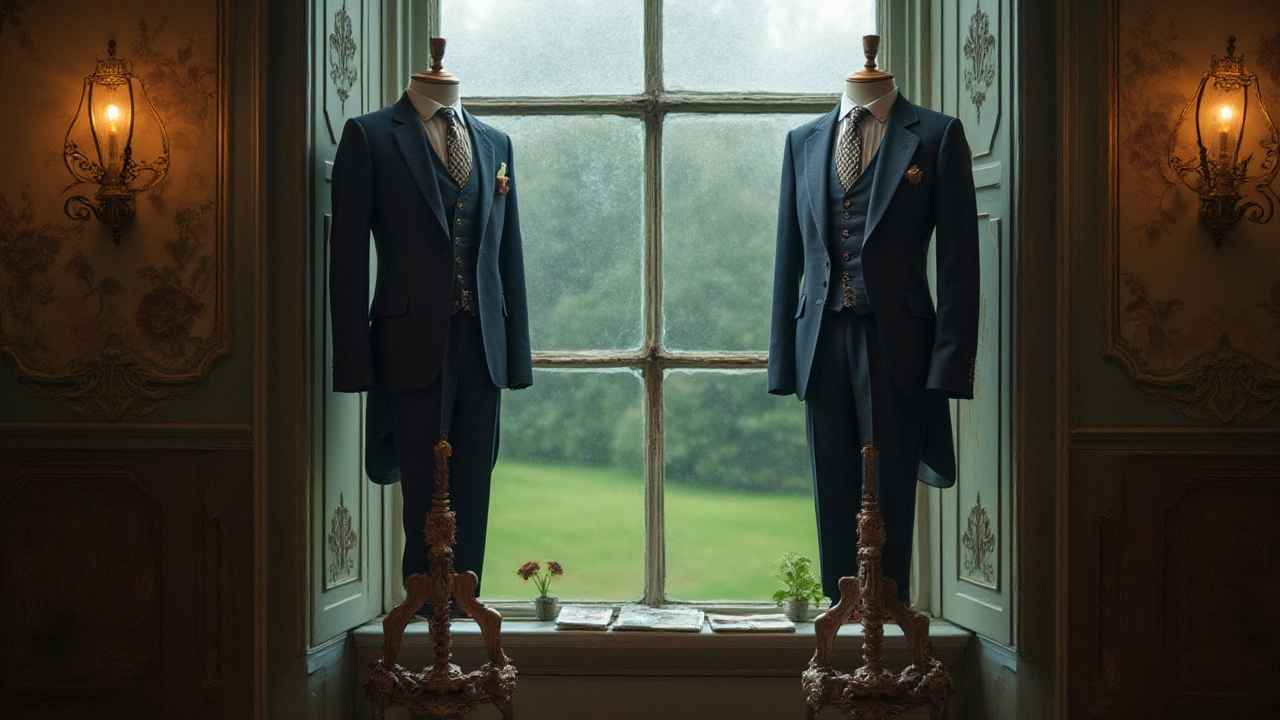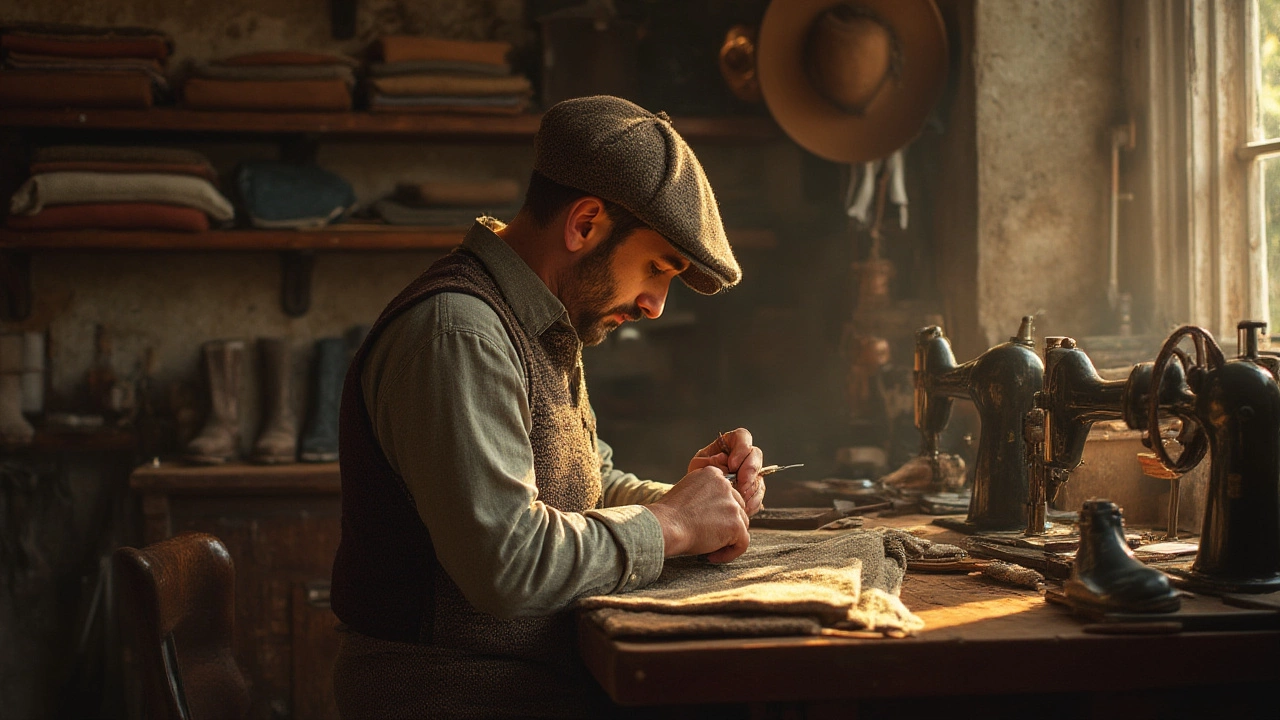Anyone wandering through Grafton Street on a Friday evening in Dublin will see it—a parade of sharp blazers, perfect lapels, the odd flash of tweed or that classic navy wool. If you’ve been shopping for suits in Ireland, or even just eyeing up the story so many Irish tailors and dry cleaners love to share, the same question crops up: is a hand sewn suit really that much better than a machine sewn one? Irish tradition would have you believe there’s a gulf between the two, that hand sewn is the only way to go—sometimes said in a tone normally reserved for Guiness debates or GAA rivalries. But what’s fact, what’s pure marketing, and what difference does it make in the drizzle outside Busáras or the mad dash for the Luas?
Irish Tailoring Traditions: Where Hand Meets History
Walk into Louis Copeland & Sons in Dublin, or ask any of the veteran tailors in Galway about their trade, and you’ll likely hear stories passed down through generations—of apprenticeships, fine wool, and needlework that takes weeks, not hours. In Ireland, hand sewn suits aren’t just about fashion; they’re stitched into the cultural fabric. Back when many families saved for years to buy one good suit—a wedding, a funeral, a family occasion—the tailor’s artistry and attention to detail became a point of pride, especially in rural counties where each suit told a family story.
Hand sewn suits made in Ireland are put together with thousands of nearly invisible stitches done by hand, not just at the hems or shoulders, but throughout the canvas and inner structure too. There’s a term traditional tailors use: floating canvas. That’s the layer inside the chest and lapels, sewn by hand so it moves naturally with the wearer. It sounds old-fashioned, but it means your suit molds around your body over time, the fit becoming almost second skin. Ask one of the retired gentlemen at Bewley’s Café on Grafton Street and you’ll hear tales of suits passed down, refitted for sons and grandsons—because Irish wool and hand tailoring can outlast decades of machine-made suits, even with our famously damp winters.
But let’s get practical—does every Dubliner, Corkonian, or Galwegian need this level of craftsmanship? Not necessarily. Hand sewing is an art, and prices reflect that. Typical hand sewn, bespoke suits from respected Irish houses like Magee 1866 or Louis Copeland start around €1,200 and can climb fast. That’s a hefty investment for the average shopper, especially when renting or buying off-the-rack can be had for a couple of hundred euro. But the feel of those soft Donegal weaves, stitched by hand, does have an old-world charm and resilience that’s not easily imitated.

The Science and Speed of Machine Sewn Suits
The arrival of sewing machines changed everything, not just in the big suit factories of Limerick or Cork, but on shop floors on the northside of Dublin too. Machine sewn suits almost always mean speed—what used to take weeks, can now be done in days or even hours. For Ireland’s younger workforce, and tourists just needing a blazer for a city wedding or a job interview, machine made suits are every bit as much a uniform as a means to look sharp. Temple Bar’s suit rental shops and O’Connell Street department stores can kit out a crowd for a rugby night or a Christmas party faster than you can pour a pint of plain.
There’s more to the story than just cost. Machine sewn suits are remarkably consistent. The stitching is tighter, and if you’re after something trendy—slim fits, bold checks, lighter summer fabrics—machines churn these out reliably, in a range of sizes that work for every Irish body type (and let’s be honest, after a few weekly trips to chipper or late-night takeaway, that matters). This consistency means it’s easy to find a ready-off-the-peg suit in larger outlets like Brown Thomas or Marks & Spencer in Dublin or Cork and not have to wait weeks for adjustments.
However, automation does have its limits. Most machine sewn suits use ‘fused’ canvas—a layer glued between the outer shell and lining. It keeps the cost and production time down but tends to make the chest and lapels stiffer, less forgiving over long hours at the office or in the unpredictable humidity of Kilkenny or Limerick. After a year or two, especially if worn regularly and left drying over a radiator during stormy season, fused suits can start bubbling or coming undone. This can lead to awkward ripples on the chest or misshapen lapels, and you’ll rarely see this with hand-stitched floating canvas. If your day jumps from the DART to meetings, to pints after work—robustness starts to matter.
Let’s put some numbers to it. According to a 2023 survey by The Irish Independent, less than 15% of men in Ireland owned a true bespoke or hand sewn suit, while nearly 70% relied on ready-to-wear, machine sewn options for daily wear. But, here’s the rub—the same group reported that their hand sewn suits lasted, on average, three times longer than their off-the-rack, mass-produced suits. It’s a trade-off: spend more now for something that could last a decade, or less for something you may be replacing every other year.
hand sewn suits may seem like an extravagance, but for big moments—weddings at Ashford Castle, a Christening in St. Patrick’s Cathedral, or that once-in-a-lifetime family photo at the Cliffs of Moher—they’re often seen as a rite of passage, a little piece of Irish legacy sewn into every seam.
| Feature | Hand Sewn Suit (Typical in Ireland) | Machine Sewn Suit (Typical in Ireland) |
|---|---|---|
| Average Cost (€) | 1,200–4,000+ | 200–700 |
| Time to Make | 4–12 weeks | 1–7 days (off-the-rack) |
| Durability (With Regular Use) | 10–25 years | 2–6 years |
| Resilience in Irish Weather | Very Good (especially with Irish wool) | Good to Fair (can suffer in humidity) |
| Fit and Comfort | Custom, molds to wearer | Standardised, can be tailored after |

Choosing the Right Suit in Ireland: When Handmade Matters
If Jasper, my ever-patient dog who tolerates my fabric samples on the kitchen table, could weigh in, he’d want something comfortable enough for walks along Sandymount Strand and robust enough to stand up to the Irish drizzle. But for us mere mortals, choosing between hand sewn and machine sewn suits boils down to occasion, budget, and what matters most to you.
Let’s say it’s your wedding next summer at Ballyfin or Powerscourt, or you need a suit for family milestones—communions, confirmations, or something to withstand the wear and tear of Irish celebrations (ceilis and all). These are the moments where hand sewn suits come into their own. You’ll get a suit shaped to your body, cut from locally spun Irish wool that handles the damp, and sturdy enough to be let out or taken in if you overindulge at the afters. Most bespoke Irish tailors like Louis Copeland, Anthony Peto, or Magee 1866 will offer a full consultation. You pick everything: the fabric (think sturdy Donegal tweeds or summer linens from Spiddal), the lining (pop a bit of personality in, if you’re feeling brave), the button stance, and even which side you want your pockets. This isn’t just a transaction; it’s an experience. Suits become family heirlooms this way, and there’s nothing more Irish than passing down good clothes for the next big occasion.
If day-to-day practicality trumps luxury, machine sewn suits still hold their own. You’ll find a huge range at Arnotts, Brown Thomas, or even smaller tailoring shops in the Liberties or Cork City. They’re an affordable way to change up your look, try a slimmer fit, or get going in short order—especially if your job means plenty of public transport, scrambling up stone steps in Dublin, or business dinners in Galway. And with a good alterations tailor (there’s a hidden gem in every town), you can get a machine sewn suit fitted pretty closely to you, particularly if you buy one of the ‘semi-bespoke’ or ‘made-to-measure’ options now popping up all over the Irish high street.
One tip if you’re shopping in Ireland’s rainy months: choose natural fibres (wool, linen, mohair) whenever you can, whether hand or machine sewn. Synthetics don’t fare well in Irish humidity, often leading to more odours and less comfort. Irish wools, especially Donegal tweed and Kerry lambswool, breathe and move with you—it’s why even the older generation still swears by them. And never underestimate the value of a good dry cleaner—ask for recommendations in your area, and stick with one who knows how to handle bespoke or delicate blends.
For the occasional suit wearer, machine sewn is a comfortable default. For those who care about tradition, ceremony, and making an entrance wherever in Ireland life takes you, hand sewn is hard to beat. And you never know, after a couple of years, you might find yourself saving up for something custom, just like grandad did.
Can you spot the difference walking along College Green or in the lobby at the Shelbourne? Maybe not at first glance, but you’ll feel it. In a country where a good story is as vital as a strong cup of tea, Irish suits—hand sewn or machine sewn—tell more than just style. They say something about your journey, your family, and where you’re headed next, rain or shine. Now, if only Jasper would stop drooling on my best jacket, I’d look sharp for every night out too.
